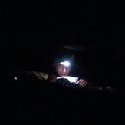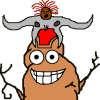|
I just read the War Nerd's Iliad and it owned. Wonder if he's gonna do The Odyssey too.
|
|
|
|

|
| # ? Jun 10, 2024 08:39 |
|
A Buttery Pastry posted:The vikings are descendants of Nordic aliens, some of whom migrated to the Mediterranean where they taught the Greeks how to make boats.  Each plank is secured with either a nail hammered through two overlapping planks and rivet or a nail that is hammered through is bent over and the tip hammered back in on the inside The Greeks made their boats with the planks matching up end-to-end and latched together with mortise and tenon, small holes drilled into both adjacent planks then a wooden dowel hammered into one side and the next plank hammered flush onto the dowels, then held tight through additional holes cut down from near the end of a plank to the edge, then laced together over another dowel.  Scandinavian ships were much sturdier in harsh weather, and waves that came at the side of the boat, the design allowed slightly more shifting and frame flexibility without leakage.
|
|
|
|
fermun posted:I know it's a throwaway joke, but the difference in how they built boats is super interesting, i think. They both started with the outside of the boat and once that was complete built a frame inside. The Scandinavians made boats in the clinker style, each plank having significant overlap with the plank above it and the plank below it. did they use wood that resisted waterlogging too? mediterranean boats had to be hauled out and dried to keep them fast and light, which had the benefit of killing the worms that live in the med that would eat the hull from the inside.
|
|
|
|
MonsieurChoc posted:I just read the War Nerd's Iliad and it owned. Wonder if he's gonna do The Odyssey too. His decision to abandon the dactylic hexameter and instead use paragraph structure to replicate the rythems of poetry in prose was amazing. I really hope he makes the Odyssey too but there has been no word of it. John's very active and responds all the time on the War Nerd Radio Facebook group if you wanted to ask him.
|
|
|
|
Real hurthling! posted:did they use wood that resisted waterlogging too? mediterranean boats had to be hauled out and dried to keep them fast and light, which had the benefit of killing the worms that live in the med that would eat the hull from the inside. They used the boats all year round but definitely dragged them up for times to do maintenance etc, and as far as I know some waterlogging of the wood is critical for sealing leaks post construction. I don't know about the waterlogging properties of the woods they used but oak was used and contains a lot of tannins which is toxic to most organisms that normally eats wood. They also used tar, and tar making is established early in the region. In addition scandinavian boats operated a lot in the baltic which is brackish and inhospitable to marine worms that eat wood and is why shipwrecks in the baltic is generally well preserved.
|
|
|
|
fermun posted:I know it's a throwaway joke, but the difference in how they built boats is super interesting, i think. They both started with the outside of the boat and once that was complete built a frame inside. The Scandinavians made boats in the clinker style, each plank having significant overlap with the plank above it and the plank below it.
|
|
|
|
i imagine futzing around in the mediterranean vs the north sea had some impact on the design but from a modern dipshit perspective the norse version seems inherently superior was the greek design somehow more suitable for ramming, boarding and those big clusterfuck sea-turned-land battles that happened in the mediterranean?
|
|
|
A Buttery Pastry posted:Was getting nice long and straight planks a limiting factor in Greek/Mediterranean ship design? compared to the near-inexhaustible forests of sweden? yes, absolutely
|
|
|
|
Goast posted:i imagine futzing around in the mediterranean vs the north sea had some impact on the design but from a modern dipshit perspective the norse version seems inherently superior It looks like the overlapping method would give you a pretty fixed width:height ratio on the hull whereas with a skeleton frame you can do whatever you please, like accommodating galley slaves for example. I am not a boat man.
|
|
|
|
|
A Buttery Pastry posted:The Greek method seems like a hassle, though I suppose it requires less wood, there being no overlap between planks? Was getting nice long and straight planks a limiting factor in Greek/Mediterranean ship design? Or is perhaps down to the evolution of ships, with Greek ships coming out of tradition where lace made a lot of sense? Thinking of those papyrus boats the Egyptians used to make, in contrast to old Scandinavian hollowed out tree trunks. i have no idea why the Greeks went that way, but they did eventually switch to the Phoenician Joint method. Phoenicians built their ships using Lebanon cypress and then used rectangular oak tenons with holes in them and oak dowels to lock the tenons in place, then chiseled little tunnels about halfway through the planks to use vertical lacing to hold planks that much tighter together. The Greeks switched to this method incredibly suddenly at some point, and the Romans copied this method after conquering Greece. idk if they all used cypress from Lebanon though or if that was just the preferred lumber  
|
|
|
|
warship oarsmen wouldnt be slaves cause they might just stop rowing and lose you the battle. if you couldnt afford to be a hoplite but could get your own oar they stuck you in the boats.
|
|
|
|
Jazerus posted:compared to the near-inexhaustible forests of sweden? yes, absolutely fermun posted:i have no idea why the Greeks went that way, but they did eventually switch to the Phoenician Joint method. Phoenicians built their ships using Lebanon cypress and then used rectangular oak tenons with holes in them and oak dowels to lock the tenons in place, then chiseled little tunnels about halfway through the planks to use vertical lacing to hold planks that much tighter together. The Greeks switched to this method incredibly suddenly at some point, and the Romans copied this method after conquering Greece. idk if they all used cypress from Lebanon though or if that was just the preferred lumber
|
|
|
|
Check out the way boats were made by Austronesian peoples in the Pacific too, kind of similar principles. Dowels and lashing, really cool stuff.
|
|
|
|
A Buttery Pastry posted:I mean, I get that we had more trees up here, but they might still have had enough for another style of boat. Though perhaps not, given the Romans stripped Crete bare. Well, it's kinda weird to discuss differences in ship building without also bringing in the great differences in environment, societal organisation, trade, warfare and tool availability which also will also greatly affect the boat building, aside from general resource availability such as for wood. As an example one can see from earlier pictures ancient scandinavian boats were generally also somewhat light and made with shallow drafts because they were made to go up rivers and larger streams and navigate dense archipelagos with plenty of shallow parts.
|
|
|
|

|
|
|
|
lmao there's a cobblestone street in a town near me and it looks very smooth but driving down it is a loving experience. no loving clue how people put up with that poo poo, and that's with my car having a modern suspension system
|
|
|
|
|
wagons go slower than a car
|
|
|
|
Slavvy posted:It looks like the overlapping method would give you a pretty fixed width:height ratio on the hull whereas with a skeleton frame you can do whatever you please, like accommodating galley slaves for example. I am not a boat man. How so? You just adjust the angle of the planks. If you look at the picture posted you can see different planks are at different angles on the same boat.
|
|
|
Weka posted:How so? You just adjust the angle of the planks. If you look at the picture posted you can see different planks are at different angles on the same boat. Because you basically HAVE to increase the width by a the thickness of a plank every time. But I'm not a boat engineer like I said.
|
|
|
|
|
Finally finished the whole thread  I love it, and you folk are *awesome* I love it, and you folk are *awesome*I'm not an academician, and I haven't done any work tracking sources of documenting anything, but... I've got an hour long epic poem I've constructed about 'The Beaver Wars.' It began when I noticed a model birch bark canoe on an elderly friend's mantle place. He shared with me a small fragment of history - in 1650, just downriver from where we stand (South Bend, Indiana), a group of frenchmen with guns approached the local Potawatomi peoples, explained to them that a war party of 150 Iroquois are staging an attack, and they put together a group of 150, each armed with a rifle, and they slipped into the Iroquois camp at night, aimed their barrels at the sleeping invaders, and executed them all at one moment. And as a teaser, he added - the lower peninsula of Michigan was abandoned for 200 years, following the great conflict. So I've shared the scraps of rumors I heard with anyone that would listen, and they'd often add some other bit that fleshed things out. Eventually I made it to Standing Rock, and then spent the trump years travelling and sharing stories and poetry and music around campfires. It's rare that I don't learn something knew from the people I tell it to. It grew to be about an hour long, and it was entirely oral tradition - never written down, not composed from library research. As a rule, when telling this story, I yield the floor if interrupted - I don't make an effort to dominate the floor or command the discussion, and I want to hear every bit of thought the piece inspires, every memory it conjures. A century and a half ago, we had the civil war. Two centuries before that, there was the revolutionary war. Another century and a half before that, was the beaver war - and it was the far, far deadlier than the other two combined. A ten thousand year old civilization, composed of ten million living humans or more, meet their end. Almost nobody remembers it. I'm gunna type up what I have and share it with y'all tonight. I'm hoping you learned types can correct some errors and flesh out or support parts of the narrative. Just tonight, following scraps and clues, I found the name of one of the characters whose story I've been telling for years - Thomas Aubert. Uglycat has issued a correction as of 03:44 on Jul 31, 2022 |
|
|
|
Slavvy posted:Because you basically HAVE to increase the width by a the thickness of a plank every time. But I'm not a boat engineer like I said. The thickness of the planks is trivial compared to the overall width of the boat. It's significantly smaller than the typical increase in width from the angle of the plank. If you wanted the boat to be narrower you could adjust that angle.
|
|
|
|
Real hurthling! posted:wagons go slower than a car give it a shot sometime, you'll love wooden wheels i did a lot of cycling on some and it really does cut a 20mph blacktop to 7mph or less
|
|
|
|
Uglycat posted:Finally finished the whole thread tldr
|
|
|
|
I like to begin this story with three scenes Dorothy's Scene: A family of Lakota, living in Wind Cave in the Black Hills, navigate - naked - in the dark. They come to the tunnel that leads to their camp, and find that it has caved in. The tunnels, down there, move. After spending some time trying to clear debris and clear the path, they give up, turn back, and look to find a new way. Joe's Scene: A Lakota man, middle-aged, trudges through the plains in winter - snow up to his knees. His two dogs bound alongside him, carrying his pack. In either hand, he has a hollowed buffalo horn, and in each horn are hot coales. Every so often, he adds a bit of dry wood to the horns. These fires keep his hands warm as he travels, and - when he reaches his camp - he sets the buffallo horns down in a snow bank, adjusts the flaps of his tipi, picks the horns back up, dumps the coals into his fire pit, adds tinder and kindling and sprinkles a dusting of dry tobacco (inner bark of red willow), and the fuel bursts into flame, with a blue flicker atop. Jacob's Scene: A Lakota warrior rides bareback on a horse, alongside a massive buffalo. He takes the bridle in his teeth, leans out away from the buffalo, and readies his shortbow (with a shortbow, you don't draw back and release; you push forward and pluck). He aims down his horse's snout, and when his shot is lined up, he jerks his head back (reins still in his teeth), giving his horse the signal to slow. As the buffalo takes the lead, the warrior looses his arrow - it connects just behind the shoulderblade, pierces the animal's heart, and the gigantic beast (charging at 40mph) tumbles to a stop. When columbus came to Turtle Island, he was a murderous, vile prick. When he went back to Spain, he brought back with him Syphilis - and left behind Spanish Horses. In that century, french jesuits spent their time prostelytizing the coasts of Africa. In service of their aim, they had to develop a fairly sophisticated approach to linguistics. When approaching a population with which you have no common tongue, and where no 'this-to-that' dictionary exists, the language barrier seems rather daunting. As a point of fact, however, you could snatch up any two humans from all of history and put them around a campfire, and if they do not kill each-other they will develop together a pidgin language. And if children grow up in an environment where a pidgin language is spoken, they will intuitively create a normative grammar, creolizing it. So the ideal approach for a jesuit to take would be: 1) camp alongside, nearby 2) bring gifts 3) graciously accept and receive whatever gifts are offered - even if they don't make sense, even if you don't imagine you have a use for it 4) listen 5) learn 6) share 7) teach in that order Now, another popular way that explorers might employ would be to kidnap a few members of the indigenous population, take them from their homes and take them as captives to Europe. The victim of the kidnapping will quickly become bilingual (and likely experience stockholm syndrome), and then you take them with you on future voyages. In any case, as fishermen start to reach newfoundland, the French decide to send vessels of their own to The New World. And where the Spanish had aimed (and claimed) South, the French decide to explore North. Now, the sailors on this french vessel (today's googling suggests the boat's name is "Pensamiento") would have been familiar with dugout canoes, like folk from India took to Australia some 55kyo. And they would have been familiar with greek triremes. And they knew viking longships. And they come over on a big tall ship. When they arrive at the Mouth of what's now known as the St. Lawrence, they find an idyllic Algonkian-speaking village - everyone happy, shiny, bright, friendly. The french sailors immediately have their minds *blown* by this civilization's means of conveyance - the birchbark canoe. Now, technically this device would be classified as 'late paleolithic' - it does not require a bellows, a furnace, or any metallurgy to create. It is, however, one of the most remarkable human inventions. With a dugout canoe, you tip over a large tree, build your fire on it, and over time carve out and stretch the log. The thing dugout canoes, longships, triremes and tall ships have in common is that you cannot simply lift them out of the water and carry them twelve miles over land and put them back down in the water. The birchbark canoe enables this use - and, as a result, there is a thriving international trade network on Turtle Island, the rivers are the highways, and the canoes are their vehicles. They can also be flipped over and used as a small tent, when you're sleeping on the shore. The french on this vessel follow the proscribed jesuit script: they camp alongside, the offer gifts, they graciously accept the gifts given to them, they listen, they learn, they share, and they teach. The crew and the village come to be friends. The french-speaking humans attempt to ask the algonkian-speaking humans, "What is the name of this [continent]." The Micmak locals interpret the question, "what do you call your village?" They respond: "Ca Na Da." The french ask, "What is the name of this river?" they are told, "This is the river that has no end." Eventually, the crew invite 7 of the natives to return to france with them on their vessel (note: I've pinned this to 1509ce). They agree. All seven reach the shores of Normandy, and are welcomed and celebrated - but each of them quickly succumbs to disease. Now, there is a science, known as 'hydronomy'; it is the study of the history of the names of bodies of water. These histories can be useful when studying the migrations of human populations. The River That Has No End, it must be said, does have an end - you can paddle your canoe inland, upriver, through the great lakes, and reach present-day Duluth. From there, you could pick your canoe up out of the water, carry it a couple dozen miles, and plop it down in what's now known as the St. Louis River - which joins up with the missouri, then the mississipi, and then out to the gulf. You could instead head south at lake michigan, where you would find the mouth of the St. Joseph River. If you follow that river south, upstream, you come to it's southern bend - present day South Bend. From there, you could pluck your canoe up, carry it 6 miles, set it down in the headwaters of the kankeekee river marsh, and punt downstream joining the illinois, the ohio, and eventually the mississippi. St. Lawrence. St. Joseph. St. Louis. These rivers have all been renamed, and renamed by catholics. The French, desiring to discover a Northwest Passage, sends another vessel back to the mouth of St. Lawrence. When they arrive, they are astonished to find that the idyllic village they remember - had been devastated. Bodies strewn about. Everything burnt. The coals - still hot. gently caress. They take a canoe upriver, and find another algonkian-speaking village. They ask, 'what the gently caress just happened back there?' They are told - 'that was the Haudenosaunee, the five nations, the little snake - the iroqouis confederacy.' (note- the name 'Sioux' is a francofied version of a slur the algonkian speaking peoples had for the Lakota - it meant, 'the big snake.') The captain dispatches a vessel back to france. On it, there's a buckskin, a beaver pelt, and word from the captain - 'don't sell guns to the iroquois.' Today, 'Iroquois' is generally used to refer to the language, and Haudenosaunee is the name of the peoples. Not all iroquois-speaking peoples are part of the 5 Nations - the Hurons and the Neutrals (from whose name we derive our word, etymologically) for example. Now, the Haudenosaunee are recent immigrants to this region. The River That Has No End has been continuously inhabited by the same population of humans for 11,000 years near it's mouth, and at least 9,000 years around the great lakes. The Haudenosaunee moved in within the last century - and appropriated the canoe technology. I don't know from where they came, I would guess the mississippi ('the mother of all waters'). I don't believe they were a barbarous people; the 'Great Law of Peace' forged the Five Nations, maybe 50 years before french first contact. It's arguably the predecessor to the US Constitution (the constitution being the great law of peace interpreted through enlightenment peoples). Now, a bit of confusion to avoid - Hiawatha was an elder that was central to the creation of the Great Law, and Hiawatha being a Haudenosaunee elder. When Henry Wadsworth Longfellow got around to writing, he penned a poem about an Algonkian-speaking person named Hiawatha. Not the same at all, though Longfellow very likely borrowed the name and didn't know he was crossing a language barrier. At least, that's the best I've worked it out (Maybe Hiawatha became a popular name among algonkian-speaking peoples too?). The Five Nations are organized like a bit of a proto-federal government. The Algonkian people has any number of alliances and trade networks, and the various overlapping hierarchies and non-hierarchical decision making entities, but they seem to be much more informal, even anarchist, especially when contrasted with the Haudenosaunee's Great Law of Peace. Back in Europe, syphilis (remember Columbus bringing it back?) reaches Paris, France. As a result of syphilis, sex workers begin going bald 'down there.' I was first told this was to enable more frequent washing and so the johns can 'inspect' a woman before agreeing to a transaction, but someone more recently told me that mercury (or was it arsenic?) was used as a remedy, and that it caused loss of pubic hair. Either way, it was becoming common for sex workers to have bare vaginas. And I don't know if it was the johns or the sex workers, but some folk really didn't like it - they preferred a grown woman with full bush. Now, Paris is, at this time, the seat of fashion in the western world. There's any number of 1%er playboys that party in paris. And there are high-end escorts that cater to these customers. And those high-end escorts also hang out with the fashion moguls. One of these fashion moguls sees an opportunity for profit, and plumbs the depths of their knowledge of materials and fabrics to invent the perfect merkin - the perfect pubic hair wig. To make this wig, they took a beaver pelt, imported at great expense from China; they pluck the long hairs, felt the short hairs, cut it to shape, and attach it with spirit gum. The result is a lovely, downy, virgin peachfuzz. And the 1%er motherfuckers I mentioned earlier? They *love* it. They start to demand top hats and vests made of this material - so they can prance around just /dripping/ sex. The beaver has already been long extinct in europe, and these pelts are being imported from the orient at top dollar, for sale to filthy wealthy pigs. This little bit of history is, it must be said, the reason 'beaver' became slang for vagina. And then the second vessel returns from the New World - and the beaver pelt is much bigger than anything available out of China. In fact, it's worth mentioning that all the animals were much bigger back then. I /think/ a tipi could be made with the hide of one single (really really big) buffalo. The Beavers were as big as Chicago Bears Fans. The Eagle was bigger then too. Fur traders and trappers and hunters of taxidermists head over to the New World. The biggest prize is beaver pelts, which command an outrageous price at this point. And there's two basic ways you could hunt beaver. The first, the 'old-school' way... you'd make camp near the mouth of the beaver dam. You'd get a pencil and a pad of paper, and you'd observe and make notes. Might take a week. When you've observed enough, you'll be able to draw a family tree depicting the inhabitants of that dam. You can then reason out which of these beasts are (renewably) harvestable, set a snare, capture the target beaver, kill it, skin it, maybe tan it (?), and move on. The second method is much newer, relying upon a quite recent invention - the match. Set one end of the dam on fire, and hold your sack over the mouth of the dam. All the beavers run into your sack, and you can kill them, skin them, and roll on. The hunters that employed matches made it upriver faster than the ones that made some effort to take care. I'm told, at one point, there was a beaver dam spanning Lake Michigan (at a narrows, I presume, but the bit that reached me did not specify), ten stories tall - that was set on fire. I haven't done the math, but that's a lot of ash and soot and biochar falling into the River That Has No End, fairly far up river. It's an ecological catastrophe. On top of that, the beaver is all but extinct and the dams have all been burned - the beaver is a keystone species. This wrecks natural fish and wildlife up and down the river. And the woods, the virgin forests on either side of the river catch flame as well. Massive forrest fires on the north and south of the great lakes, emanating out from (let's say) Mackinak Bear in mind, the 'river' I keep referring to is 20% of the world's fresh water, in addition to being the highway upon which this canoe-going civilization is built. And I never have found an account for why the Haudenosaunee burned down that Algonkian village on the mouth of the River that has no end, but I have a hypothesis. I believe smallpox arrived on turtle island with the very first french vessel. I believe the algonkian elder that reached Normandy was exposed to the virus before leaving turtle island. It seems to me as though smallpox decimated that village, and then ripped upriver, jumping from community to community. Now, the Five Nations have recently posted up right around where that first contact happened. And they formed a sort of federal government. They would have noticed the horrible plague ripping through the local populations, and held council. I entertain the hypothesis that the burning of the village was a effort by the Five Nations to stop the horror by arriving at it's origin point and burning everything. And the second french vessel arrived just after the burn party wrapped up their work. So we have a plague ripping upriver, killing significant portions of any given population with each successive wave. We have environmental ruin, with the extinction of the beaver, the burning of the dams and surrounding woods, all the soot and ash in the water... All this land was inhabited. Ten million humans lived along these lakes. Another 90 million lived on the continent at this time, and there was, as I said, a vast international trade network. And disease hits these towns, villages and camps. And the water goes bad and all the critters die. And these white people keep showing up in greater and greater numbers to hunt and trade. And the french, as a rule, do not trade guns with the haudenesaunee. They /do/ trade guns with the algonkian-speaking peoples. Now the native anarchists have guns, and the Five Nations feds have only their traditional weapons (tomahawks, bone knives, bow and arrow, etc). And aggressions are increasing. Jockeying for control over fur trade routes, grudges that get out of hand, and the with civilization collapse happening around them, aggressions grow and desperation dominates. Everything becomes aggravated. If you head over to The New World hoping to make your fortune, you don't want to simply gather as many beaver pelts as you can carry, haul them back to the dock and thumb it back to Europe. No, you'll wanna trade them for smaller trinkets that are lighter and smaller. You want to fill your purse, *then* catch a ride back home. Around this time, the natives that columbus had tried to enslave were dying off en masse, and a the 'atlantic slave trade' was being born. Humans and cotton were dominant cargo. The dutch are involved. Somewhere in here, the first publicly traded company, the Dutch East India company, is founded. They bring coins over to The New World. Back in europe, the dutch and the french are openly warring. A strategic alliance forms between the Five Nations and the Dutch. Guns are exchanged. It's now full-out war between the haudenasaunee and much of the algonkian-speaking peoples. The french and the dutch are shooting at each-other. Piracy and lawlessness rains - if your gang controls both sides of the river at a narrows, any passing barges become yours and all you have to do is kill it's occupants and toss their bodies in the woods. Plague continues up and down the river. Around this time, you could bring your buckskin into a tavern and exchange it for silver. One buckskin in good order was worth one ounce silver. One ounce silver would get you put up at an inn, fed, drunk, sucked off, sleep 'til rested, fed again and on your way. For a buck. A silver dollar. Okay, so now we have full-blown capitalism, all-out war, environmental ruin, devastating plagues (oh yeah, hep and other poo poo is goin' 'round too). At this point, the Five Nations plot an insane campaign of terror. One hundred and fifty men, the sides of their heads bare (plucked, one by one, with clamshells - *not* shaved), traditional weapons, and canoes. They head upstream, employing the following strategy: When they approach a town, village, or camp, they post up downriver and wait for sundown. At dark, they sneak into camp, silently kill any watchpersons, position themselves strategically, at trailheads or outside tents, and then they all shriek their frightening war whoop at once. As the population wakes, startled, and stumbled panicking out of their tents - their heads are caved in, their flesh is pierced, or some other bad end befalls them. These warriors - mostly Mohawk - slaughter almost every person in almost every town, camp and village they encounter. They often leave one person alive, torture them, and leave them to tell the story. They also engage in cannibalism - and not the 'we're hungry and you're made of meat' cannibalism; rather, the 'you've wronged us so we're going to eat your children in front of you' cannibalism. After destroying a camp, they resupply and head further upriver. And so they set out, from New Jersey. By the time they reached Lake Michigan, a french outfit was hunting them. Where the war party went through the lakes, and turned south, the french figured they were heading for the southern bend of the st. joseph river, and they plotted a course to intercept. I don't know if these frenchmen took canoes, cutting across the lower penensula of michigan, hopping from river to river at strategic portages, or if they took a wagon train along trails - but I know they brought a large cache of weapons with them. The french may have been concerned that the campaign would take the portage and continue all the way down the mississipi, all the way to new orleans. The Haudensaunee war party and the frenchmen hunting them arrive at present-day South Bend at the same time. The war party makes camp, and the french visit the Council Oak of the Potowatomi, the local algonkian-speaking tribe. They tell them, there's bastards on your back doorstep, they pose a clear and present danger, an existential threat, you'd be totally justified in a pre-emptive strike, they're going to murder every last one of you, we brought a bunch of guns, we know where they're camped - you wanna tag along on this hit? And they snuck up on the war party as they slept, pointed 150 barrels at 150 heads, and killed them all at once. 1650ce. The Lower Peninsula of Michigan was occupied by the 'Three Fires Alliance' - the Potowatomi, the Chippewa, and the Ottowa. These tribes /flee/. The plague and catastrophe is too much for them, and they migrate around Lake Michigan. Their refugee camp never closed - it grew, and became Madison Wisconsin. The descendants of this migration know themselves as the 'Ojibwe' people - derived from 'chippewa.' But the land they moved to was, like all livable land on the continent, occupied. These Ojibwe people had guns, and horses, and carried pox with them - and they displaced the Nakota people from the western shores of lake michigan. The Nakota were forced south, and west, and they displace the Lakota - exposing /them/ to smallpox. I don't think the Lakota has horses yet, at this point - though it's difficult to say for sure. They didn't have guns - the Ojibwe would have had the advantage as conflict arose. By this point, the 10 million people who lived along the great lakes was reduced to ... well, I don't know. I'd wager less than a million, but I just don't know. Anyhow, 20 years later LaSalle followed a rumor that the Miami people post up on an interchange between the great lakes and the mississipi, and looking for them he came across the portage and is thought by most to be the first white person to visit the natives here. Now, I started this narrative with stories of the Lakota people. Those stories form a simple timeline. The Lakota lived in Wind Cave. Then they exited the cave, and the white buffalo calf woman gave them the seven rites (tipis, sweat lodges, etc) and teaches them to follow the buffalo in a sustainable nomadic pedestrian life. Then the plague hits them, killing 90%, in the mid 1600's. A generation later, they get the horse. In 1806, they meet their first white people - Lewis and Clark, returning from Washington State. This sets the stage for the 'French-Indian Wars', where George Washington makes his entrance. Around 1820, white people with carts and ox roll up on a beautiful pristine confluence of rivers, an edible forest left abandoned two hundred years earlier. In the shallows of the water are arrowheads, made of flint, the only remains of an ancient, pre-historic battle with no recorded history. They name the camp Flint, Michigan. Uglycat has issued a correction as of 08:18 on Jul 31, 2022 |
|
|
|
*has a stroke, dies*
|
|
|
|
|
https://mobile.twitter.com/TalatBanday/status/1553298066651975680
|
|
|
|
Uglycat posted:So I've shared the scraps of rumors I heard with anyone that would listen, and they'd often add some other bit that fleshed things out. this is the Herodotus method isn’t it?
|
|
|
birdstrike posted:this is the Herodotus method isn’t it? drake no: jakarta method drake yes: herodotus method
|
|
|
|
|
neutral is etymologically Latin not native american
|
|
|
|
quote:The artwork on the Orloj became the center of controversy after a local heritage group noticed the reproduction had "radically changed the appearance, ages, skin tone, dress and even genders of the figures" illustrated by Mánes in 1866. A member of the Club for Old Prague, Milan Patka, registered a complaint with the Ministry of Culture, alleging that in the restoration, painter Stanislav Jirčík had deviated from the "spirit and detail" of the original.[16] The National Heritage Inspectorate began investigations into the allegations.
|
|
|
|
birdstrike posted:this is the Herodotus method isn’t it? Pretty much, yeah. Might have been Homer's - it's kindve an unreliable oral prehistory. I wouldn't describe the narrative as 'factual', and it's a constantly shifting. I didn't set out to do this on purpose, and there's zero academic rigor.
|
|
|
|
Zero academic rigor? When's the book coming out?
|
|
|
|
 puritans...good?!
|
|
|
|
of all the time periods and cultures to be born into, being a 1600s calvinist has got to be one of the worst
|
|
|
|
i say swears online posted:of all the time periods and cultures to be born into, being an american has got to be the worst
|
|
|
|
Some Guy TT posted:
Oh you want to have fun for 12 days per year? No, God put you on this earth to hate it. Now eat your gruel and get ready to pray for three hours
|
|
|
|
i ain't reading all that but are you just saying that syphilis etc. brought over by the europeans ran way ahead of the europeans themselves, destroying native american societies and leading to dozens of millions of direct and indirect deaths? i thought that was pretty uncontroversial these days
|
|
|
Mola Yam posted:i ain't reading all that There was also a broader collapse of trade networks already well underway as the Mississippian culture splintered and fragmented before Europeans showed up. Causes are still under heavy debate, but regardless it was a perfect storm of poo poo.
|
|
|
|
|
no matter precolombian societal disintegration, i think transmissable diseases did 90% of the work, and i think some US scholarship of precolombian cultures is biased to perpetuate an idea of open wilderness for settlement
i say swears online has issued a correction as of 00:16 on Aug 1, 2022 |
|
|
|

|
| # ? Jun 10, 2024 08:39 |
|
Mola Yam posted:i ain't reading all that Didn't syphilis travel the other way?
|
|
|





























